Evaluation of Rainfall Interception by Vegetation Using a Rainfall Simulator
Abstract
1. Introduction
2. Materials and Methods
2.1. Location, Soil, and Vegetation
2.2. Rainfall Simulator Tests
2.3. Interpretation of Rainfall Simulation Tests and Determination of the Interception
3. Results and Discussion
3.1. Tests in the RS
3.2. Quantification of the Interception
4. Conclusions
Author Contributions
Funding
Institutional Review Board Statement
Informed Consent Statement
Data Availability Statement
Acknowledgments
Conflicts of Interest
References
- Lu, D.; Hetrick, S.; Moran, E. Impervious surface mapping with Quickbird imagery. Int. J. Remote Sens. 2011, 32, 2519–2533. [Google Scholar] [CrossRef] [PubMed]
- Weng, Q. Remote sensing of impervious surfaces in the urban areas: Requirements, methods, and trends. Remote Sens. Environ. 2012, 117, 34–49. [Google Scholar] [CrossRef]
- Lin, Q.; Xu, Q.; Faqi, W.; Li, T. Effects of wheat in regulating runoff and sediment on different slope gradients and under different rainfall intensities. Catena 2019, 183, 104–116. [Google Scholar] [CrossRef]
- Alves, P.L. Capacidade de Interceptação pelas árvores e suas Influências no Escoamento Superficial Urbano. Ph.D. Thesis, University of Goias, Goiânia, Brazil, 2015. [Google Scholar]
- Alves, P.L.; Formiga, K.T.M. Efeitos da arborização urbana na redução do escoamento pluvial superficial e no atraso do pico de vazão. Ciênc. Florest. 2019, 29, 193–207. [Google Scholar] [CrossRef]
- Rahardjo, H.; Krisnanto, S.; Leong, E.C. Effectiveness of capillary barrier and vegetative slope covers in maintaining soil suction. Soils Rocks 2016, 39, 51–69. [Google Scholar]
- Mendes, T.A. Physical and Numerical Modeling of Infiltration and Runoff in Unsaturated and Vegetative Coverage Surfaces. Ph.D. Thesis, University of Brasília, Brasília, Brazil, 2019. [Google Scholar]
- Tucci, C.; Clarke, R.T. Impacto das mudanças da cobertura vegetal no escoamento: Revisão. Rev. Bras. Recur. Hidr. 1997, 2, 135–152. [Google Scholar] [CrossRef]
- Elliot, W.J. Modeling Rangeland Watershed Erosion Processes. In Proceedings of the Watershed Management and Operations Management, Fort Collins, CO, USA, 20–24 June 2000; Volumn 2, pp. 1–9. [Google Scholar] [CrossRef]
- Zhang, X.; Li, P.; Li, Z.B.; Yu, G.Q.; Li, C. Effects of precipitation and different distributions of grass strips on runoff and sediment in the loess convex hillslope. Catena 2018, 162, 130–140. [Google Scholar] [CrossRef]
- Moura, A.E.S.S.; Correa, M.M.; Silva, E.R.; Ferreira, R.L.C.; Figueiredo, A.C.; Possas, J.M.C. Interceptação das chuvas em um fragmento de floresta da Mata Atlântica na Bacia do Prata, Recife, PE. Rev. Árvore 2009, 461–469. [Google Scholar] [CrossRef][Green Version]
- Mcpherson, E.G.; Simpson, J.R.; Xiao, Q.; Wu, C.H. Million trees Los Angeles canopy cover and benefit assessment. Landsc. Urban. Plan. 2011, 99, 40–50. [Google Scholar] [CrossRef]
- Ghimire, C.P.; Bruijinzell, L.A.; Lubczynski, M.W.; Bonell, M. Rainfall interception by natural and planted forests in the Middle Mountains of Central Nepal. J. Hydrol. 2012, 475, 270–280. [Google Scholar] [CrossRef]
- Zhang, Y.; Wang, X.; Hu, R.; Pan, Y.; Paradeloc, M. Rainfall partitioning into throughfall, stemflow and interception loss by two xerophytic shrubs within a rain-fed re-vegetated desert ecosystem, northwestern China. J. Hydrol. 2015, 527, 1084–1095. [Google Scholar] [CrossRef]
- Clark, O.R. Interception of rainfall by prairie grasses, weeds, and certain crop plants. Ecol. Monogr. 1940, 10, 243–277. [Google Scholar] [CrossRef]
- Calder, A. Evaporation in the Uplands; John Wiley & Sons Ltd.: Chichester, UK, 1990; 148p. [Google Scholar]
- Martinez, G.; Weltz, M.; Pierson, F.B.; Spaeth, K.E.; Pachepsky, Y. Scale effects on runoff and soil erosion in rangelands: Observations and estimations with predictors of different availability. Catena 2017, 151, 161–173. [Google Scholar] [CrossRef]
- Moreno-De Las Heras, M.; Nicolau, J.M.; Merino-Martín, L.; Wilcox, B.P. Plot-scale effects on runoff and erosion along a slope degradation gradient. Water Resour. Res. 2010, 46, 1–12. [Google Scholar] [CrossRef]
- Fu, Z.; Li, Z.; Cai, C.; Shi, Z.; Xu, Q.; Wang, X. Soil thickness effect on hydrological and erosion characteristics under sloping lands: A hydropedological perspective. Geoderma 2011, 167–168, 41–53. [Google Scholar] [CrossRef]
- Shao, Q.; Baumgartl, T. Estimating input parameters for four infiltration models from basic soil, vegetation, and rainfall properties. Soil Sci. Soc. Am. J. 2014, 78, 1507–1521. [Google Scholar] [CrossRef]
- Oorthuis, R.; Hürlimann, M.; Fraccica, A.; Lloret, A.; Moya, J.; Puig-Polo, C.; Vaunat, J. Monitoring of a full-scale embankment experiment regarding soil–vegetation–atmosphere interactions. Water 2018, 10, 688. [Google Scholar] [CrossRef]
- Vianna, V.F.; Fleury, M.P.; Menezes, G.B.; Coelho, A.T.; Bueno, C.; Silva, J.L.; Luz, M.P. Bioengineering Techniques Adopted for Controlling Riverbanks’ Superficial Erosion of the Simplício Hydroelectric Power Plant, Brazil. Sustainability 2020, 12, 7886. [Google Scholar] [CrossRef]
- Liu, Y.; Hu, J.M.; Wang, T.W.; Cai, C.F.; Li, Z.X.; Zhang, Y. Effects of vegetation cover and road-concentrated flow on hillslope erosion in rainfall and scouring simulation tests in the Three Gorges Reservoir Area, China. Catena 2016, 136, 108–117. [Google Scholar] [CrossRef]
- Wang, Y.; You, W.; Fan, J.; Jin, M.; Wei, X.; Wang, Q. Effects of subsequent rainfall events with different intensities on runoff and erosion in a coarse soil. Catena 2018, 170, 100–107. [Google Scholar] [CrossRef]
- Langhans, C.; Diels, J.; Climans, W.; van den Putte, A.; Govers, G. Scale effects of runoff generation under reduced and conventional tillage. Catena 2019, 176, 1–13. [Google Scholar] [CrossRef]
- Melo, M.T.; Palmeira, E.M.; Santos, E.C.; da Luz, M.P. Geosynthetic performance against slope erosion caused by high intensity rainfall. Geosynth. Int. 2020, 27, 1–49. [Google Scholar]
- Šimůnek, J.; van Genuchten, M.T. Modeling nonequilibrium flow and transport processes using HYDRUS. Vadose Zone J. 2008, 7, 82–97. [Google Scholar] [CrossRef]
- Shouse, P.J.; Ayars, J.E.; Šimůnek, J. Simulating root water uptake from a shallow saline groundwater resource. Agric. Water Manag. 2011, 98, 84–90. [Google Scholar] [CrossRef]
- Soulis, K.X.; Valiantzas, J.D.; Ntoulas, N.; Kargas, G.; Nektarios, P.A. Simulation of green roof runoff under different substrate depths and vegetation covers by coupling a simple conceptual and a physically based hydrological model. J. Environ. Manag. 2017, 200, 434–445. [Google Scholar] [CrossRef]
- Gubiani, P.I.; Mentges, L.R. Using root water uptake estimated by a hydrological model to evaluate the least limiting water range. Rev. Bras. Ciênc. Solo 2020, 44. [Google Scholar] [CrossRef]
- Šimůnek, J.; Sejna, M.; van Genuchten, M.T. The HYDRUS-2D Software Package for Simulating the Two-Dimensional Movement of Water, Heat, and Multiple Solutes in Variably-Saturated Media: Version 2.0; Agricultural Research Service, US Department of Agriculture: Riverside, CA, USA, 1999. [Google Scholar]
- Cai, G.; Vanderborght, J.; Couvreur, V.; Mboh, C.M.; Vereecken, H. Parameterization of root water uptake models considering dynamic root distributions and water uptake compensation. Vadose Zone J. 2017, 17, 2–21. [Google Scholar] [CrossRef]
- Sutanto, S.J.; Wenninger, J.; Coenders-Gerrits, A.M.J.; Uhlenbrook, S. Partitioning of evaporation into transpiration, soil evaporation and interception: A comparison between isotope measurements and a HYDRUS-1D model. Hydrol. Earth Syst. Sci. 2012, 16, 2605–2616. [Google Scholar] [CrossRef]
- Keim, R.F.; Tromp-Van Meerveld, H.J.; Mcdonnell, J.J. A virtual experiment on the effects of evaporation and intensity smoothing by canopy interception on subsurface stormflow generation. J. Hydrol. 2006, 327, 352–364. [Google Scholar] [CrossRef]
- Mendes, T.A.; Gitirana, G.F.N., Jr.; Rebolledo, J.F.R.; Vaz, E.F.; Da Luz, M.P. Numerical evaluation of laboratory apparatuses for the study of infiltration and runoff. Braz. J. Water Res. 2020, 25. [Google Scholar] [CrossRef]
- Araújo, A.G. Análise do Desempenho de Poços de Infiltração na Cidade de Goiânia. Master’s Thesis, University of de Goias, Goiânia, Brazil, 2013. [Google Scholar]
- Kühn, V.O. Resistência ao Cisalhamento de um Solo Tropical não Saturado Considerando Altas Sucções. Master’s Thesis, University of de Goias, Goiânia, Brazil, 2014. [Google Scholar]
- Laguna, M.A.A. Comportamento Hidromecânico de um solo Argiloso Compactado em Diferentes Umidades. Master’s Thesis, University of Goias, Goiânia, Brazil, 2015. [Google Scholar]
- Araújo, A.G. Uso de Microtomografia e Porosimetria para análise da Estrutura Bimodal de um Latossolo Vermelho Reconstituído. Ph.D. Thesis, University of Goias, Goiânia, Brazil, 2019. [Google Scholar]
- Vaz, E.F. On the Equilibrium of Suction and Pressure Plate Tests. Master’s Thesis, University of Goias, Goiânia, Brazil, 2019. [Google Scholar]
- Mendes, T.A.; Sávio, A.S.P.; Rebolledo, J.F.R.; Gitirana, G.F.N., Jr.; Melo, M.T.S.; Da Luz, M.P.S. Development of a rainfall and runoff simulator for performing hydrological and geotechnical tests. Sustainability 2021, 13, 3060. [Google Scholar] [CrossRef]
- Egeli, I.; Pulat, H.F. Mechanism and modelling of shallow soil slope stability during high intensity and short duration rainfall. Sci. Iran. 2011, 18, 1179–1187. [Google Scholar] [CrossRef]
- Souza, S.F.D., Jr.; Mendes, T.A.; Siqueira, E.Q.D. Development and calibration of a rainfall simulator for hydrological studies. Braz. J. Water Res. 2017, 22. [Google Scholar] [CrossRef]
- Kim, H.; Ko, T.; Jeong, H.; Ye, S. The development of a methodology for calibrating a large-scale laboratory rainfall simulator. Atmosphere 2018, 9, 427. [Google Scholar] [CrossRef]
- Jadhao, V.G.; Bhattarai, R.; Pandey, A.; Mishra, S.K. Performance evaluation of a rainfall simulator in laboratory. In Water Management and Water Governance; Pandey, A., Mishra, S.K., Kansal, M.L., Singh, R.D., Singh, V.P., Eds.; Springer: Cham, Switzerland, 2020; pp. 375–391. [Google Scholar] [CrossRef]
- Minguntanna, N.S. Determining a Set of Surrogate Parameters to Evaluate Urban Stormwater Quality. Master’s Thesis, Faculty of Built Environment and Engineering, Queensland University of Technology, Brisbane, QLD, Australia, 2009. [Google Scholar]
- Decagon Devices Inc. Soil Moisture Sensors: User’s Manual; Decagon Devices Inc.: Pullman, WA, USA, 2008. [Google Scholar]
- UMS. User’s Manual—T5 Tensiometer. Available online: http://library.metergroup.com/Manuals/UMS/T5_Manual.pdf (accessed on 23 March 2021).
- Drastig, K.; Quiñones, T.S.; Zare, M.; Dammer, K.H.; Prochnow, A. Rainfall interception by winter rapeseed in Brandenburg (Germany) under various nitrogen fertilization treatments. Agric. For. Meteorol. 2019, 268, 308–317. [Google Scholar] [CrossRef]
- Gardon, F.R.; Toledo, R.M.; Brentan, B.M.; Santos, R.F. Rainfall interception and plant community in young forest restorations. Ecol. Indic. 2020, 109, 105779. [Google Scholar] [CrossRef]
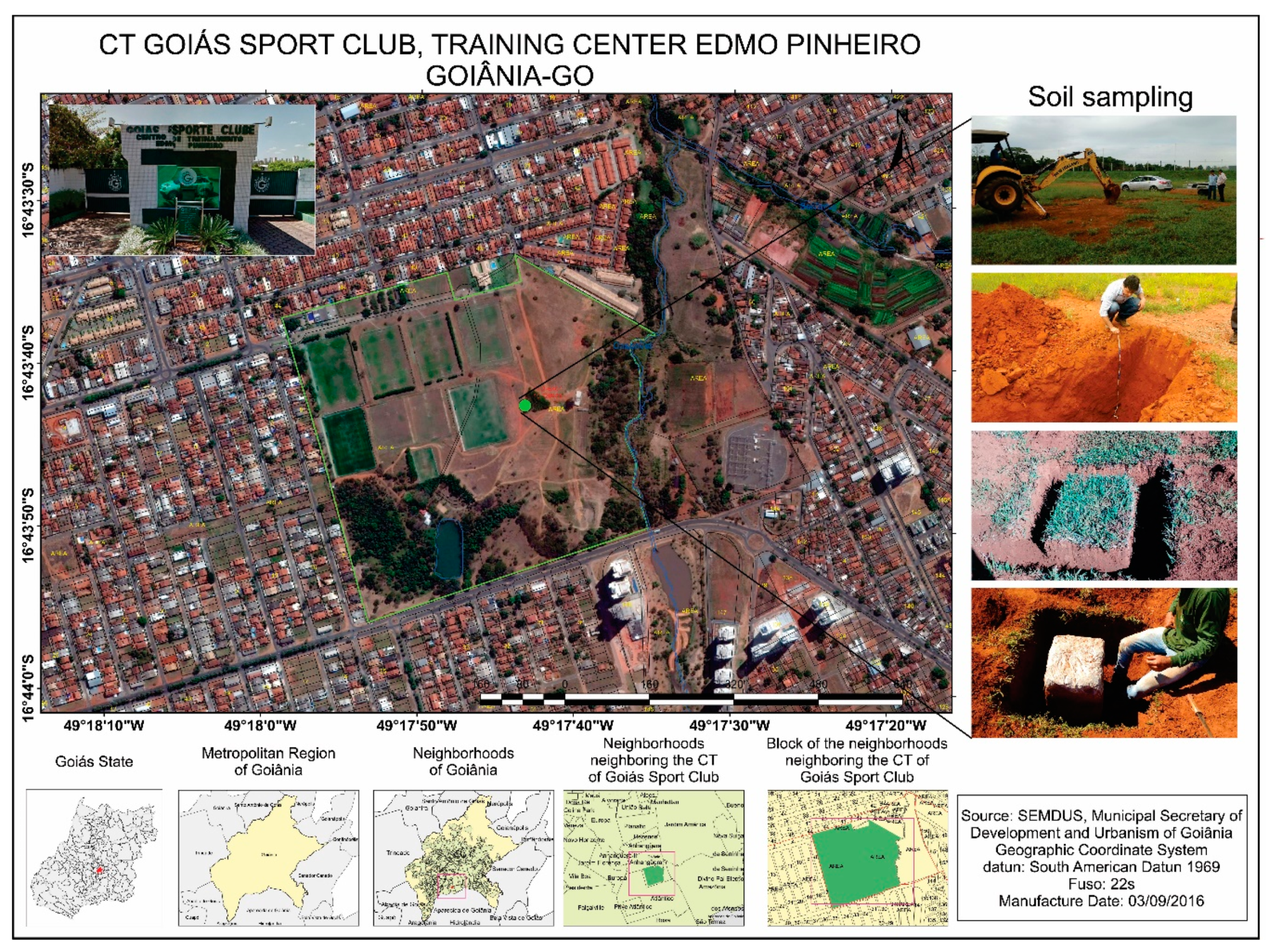
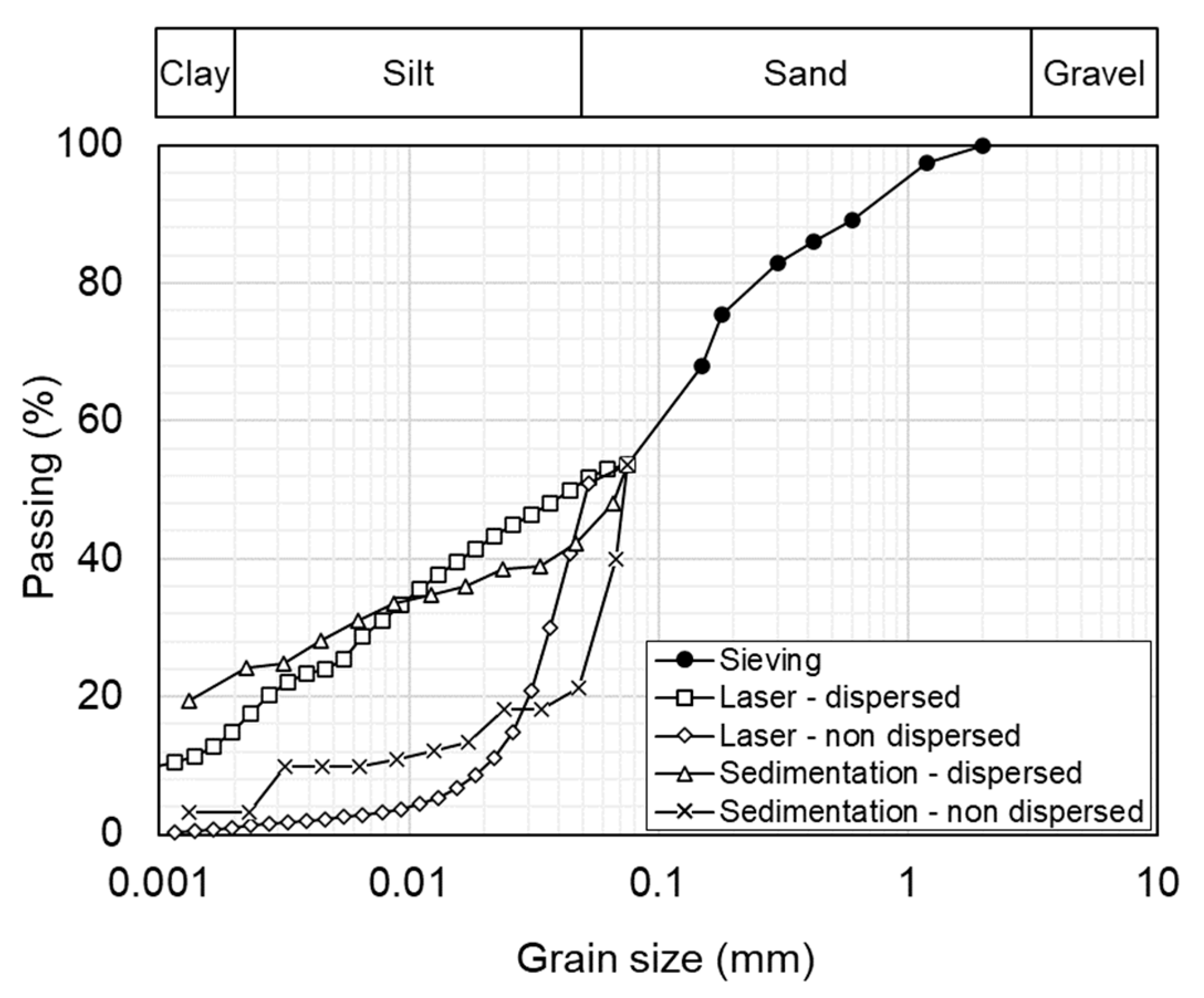
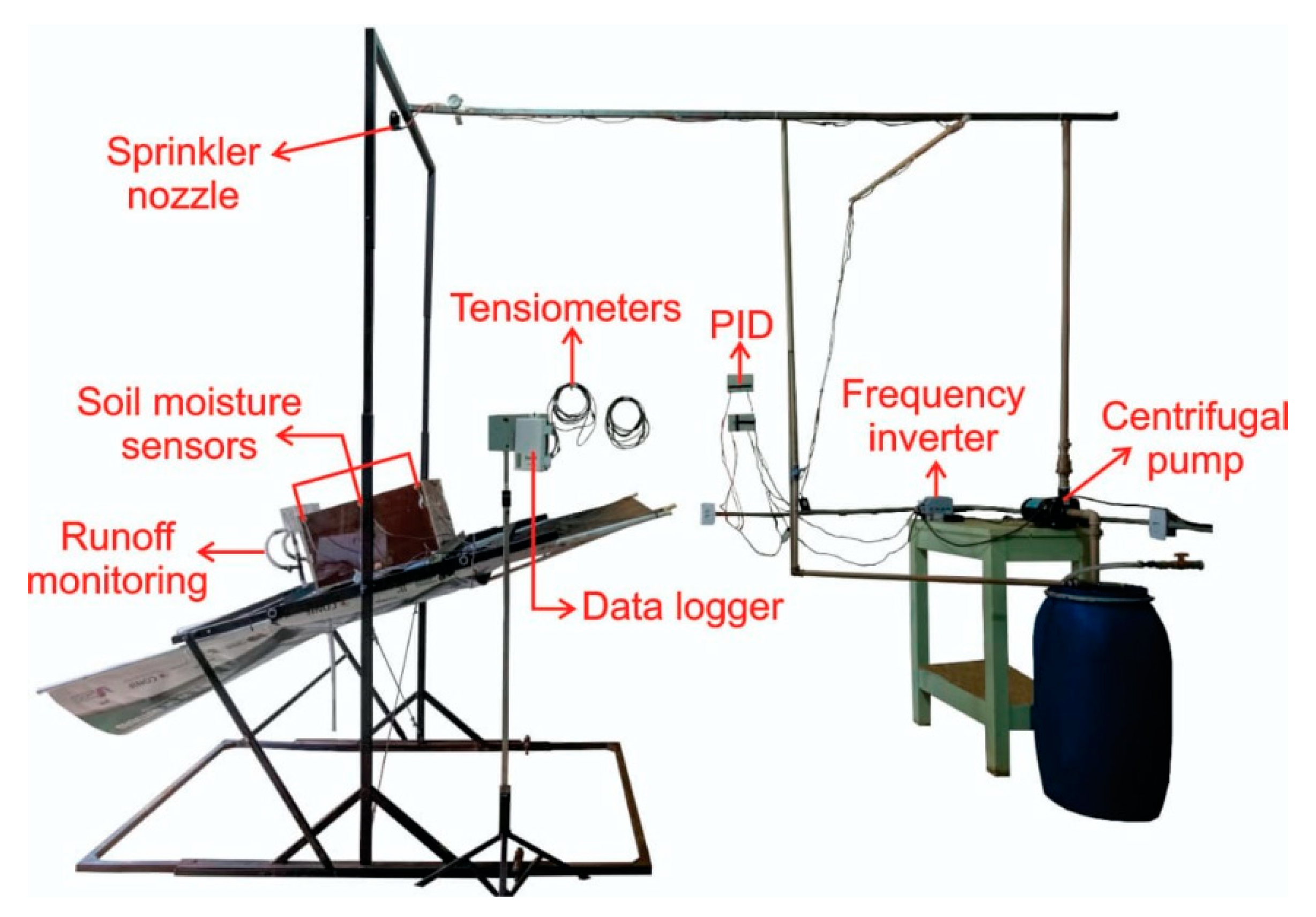

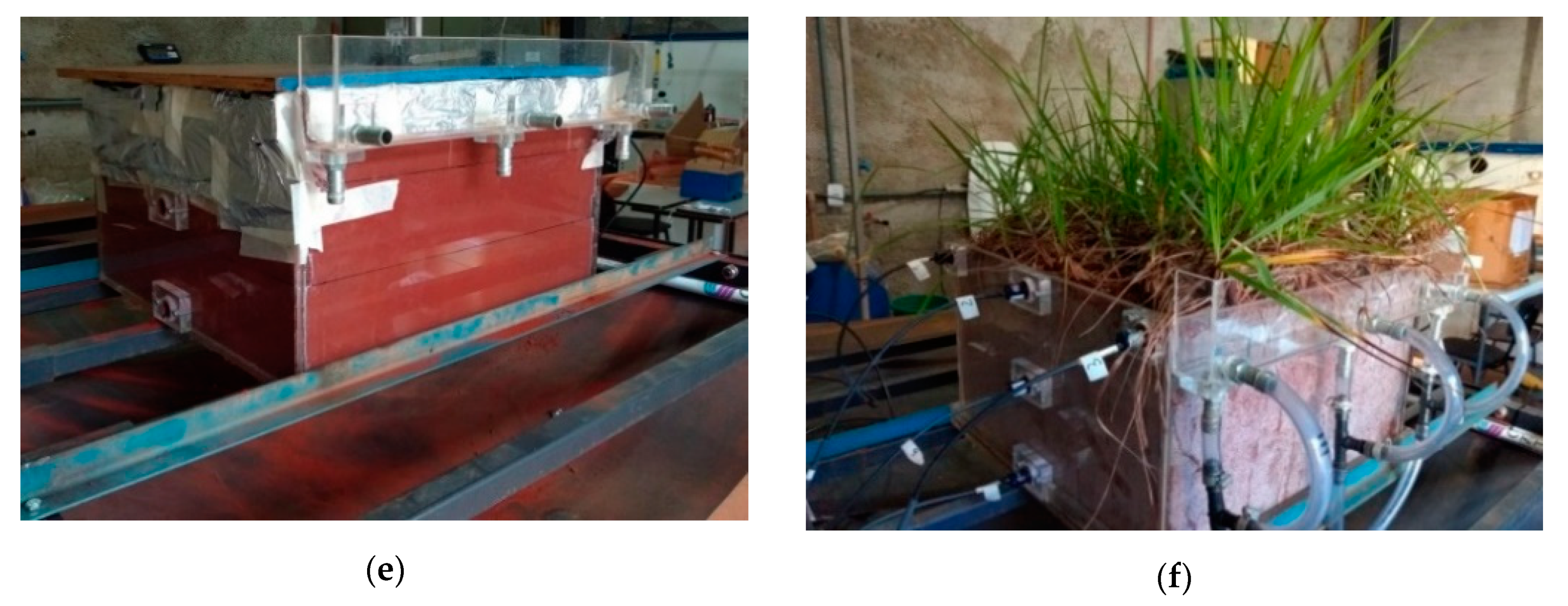
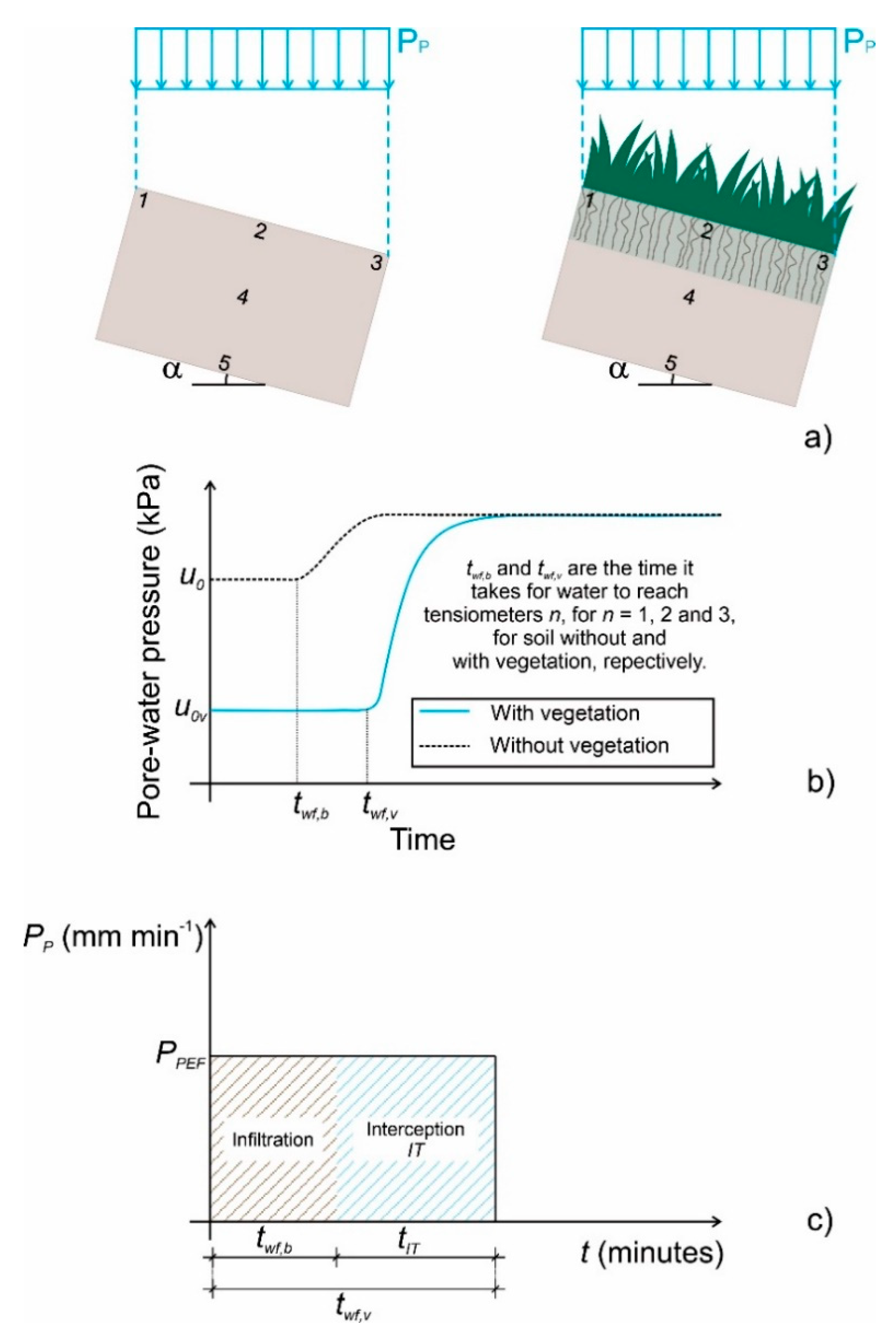
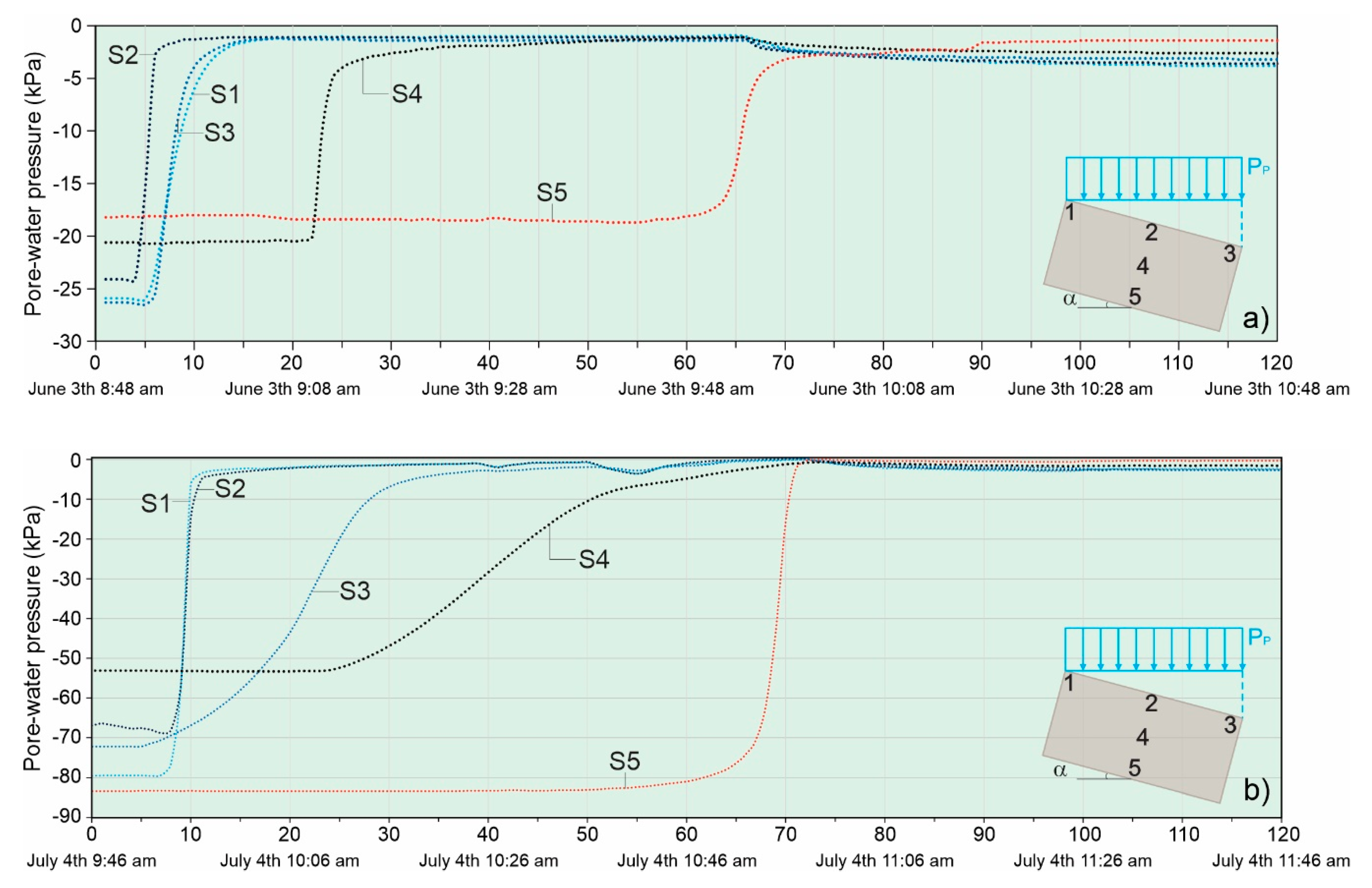
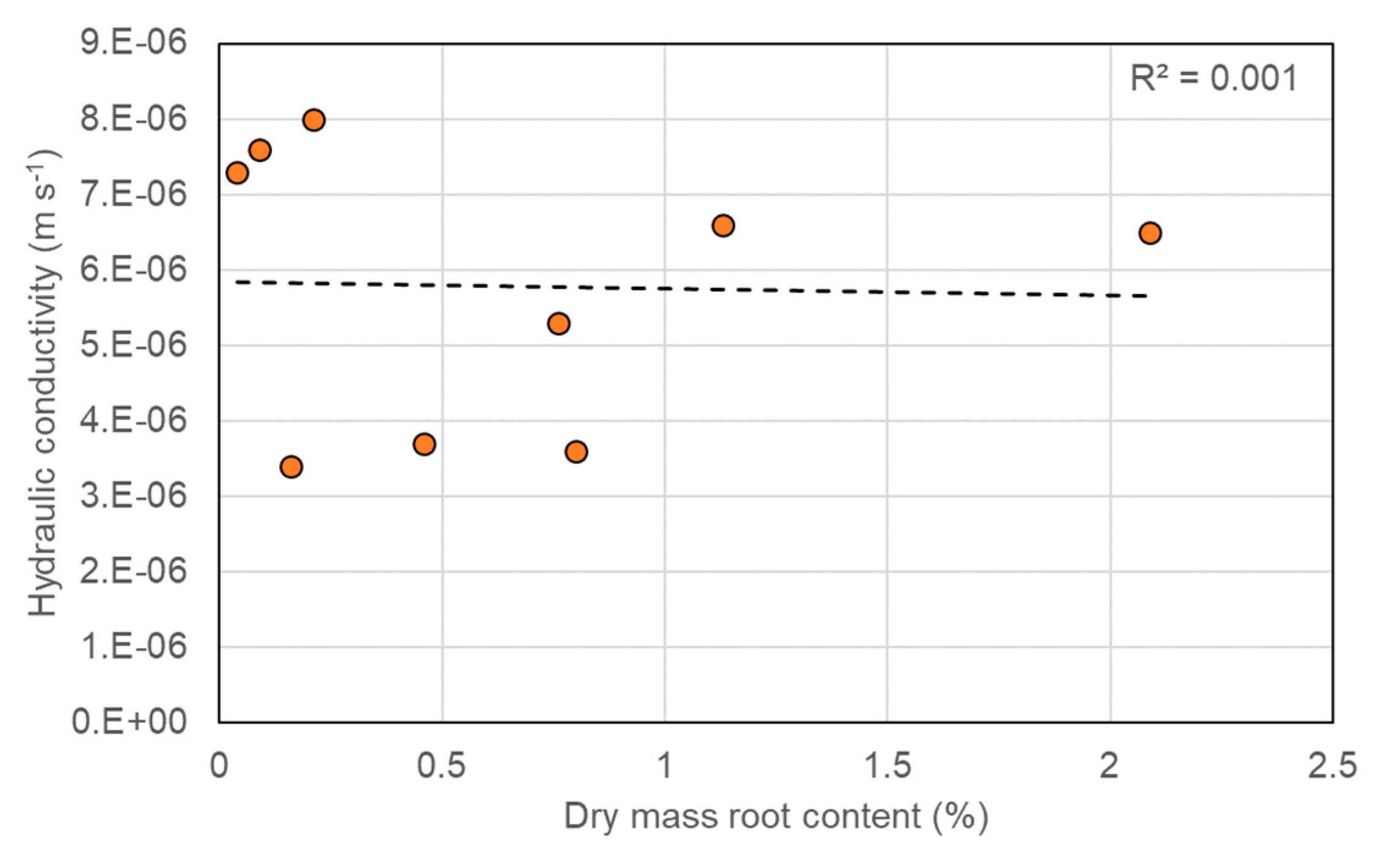
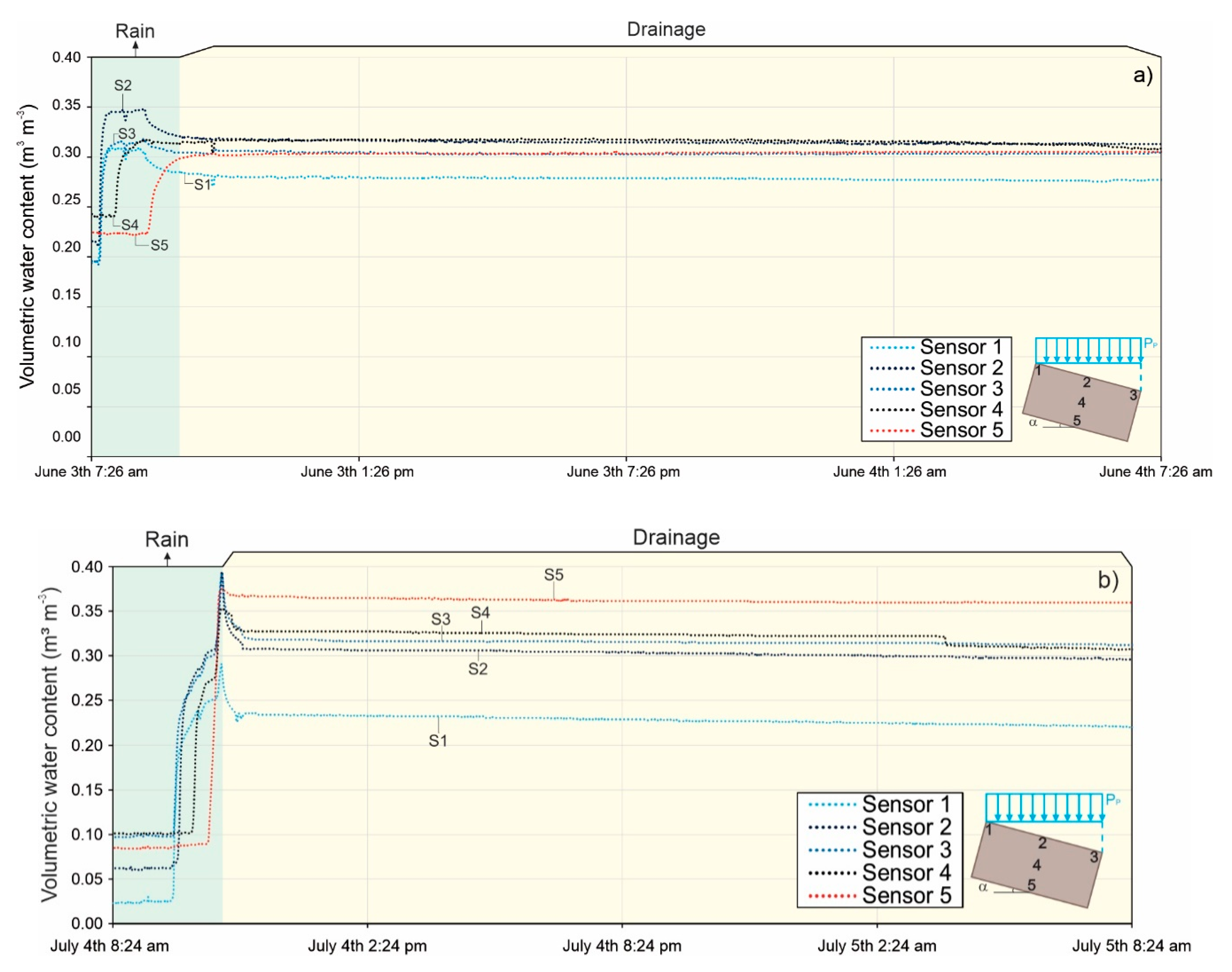
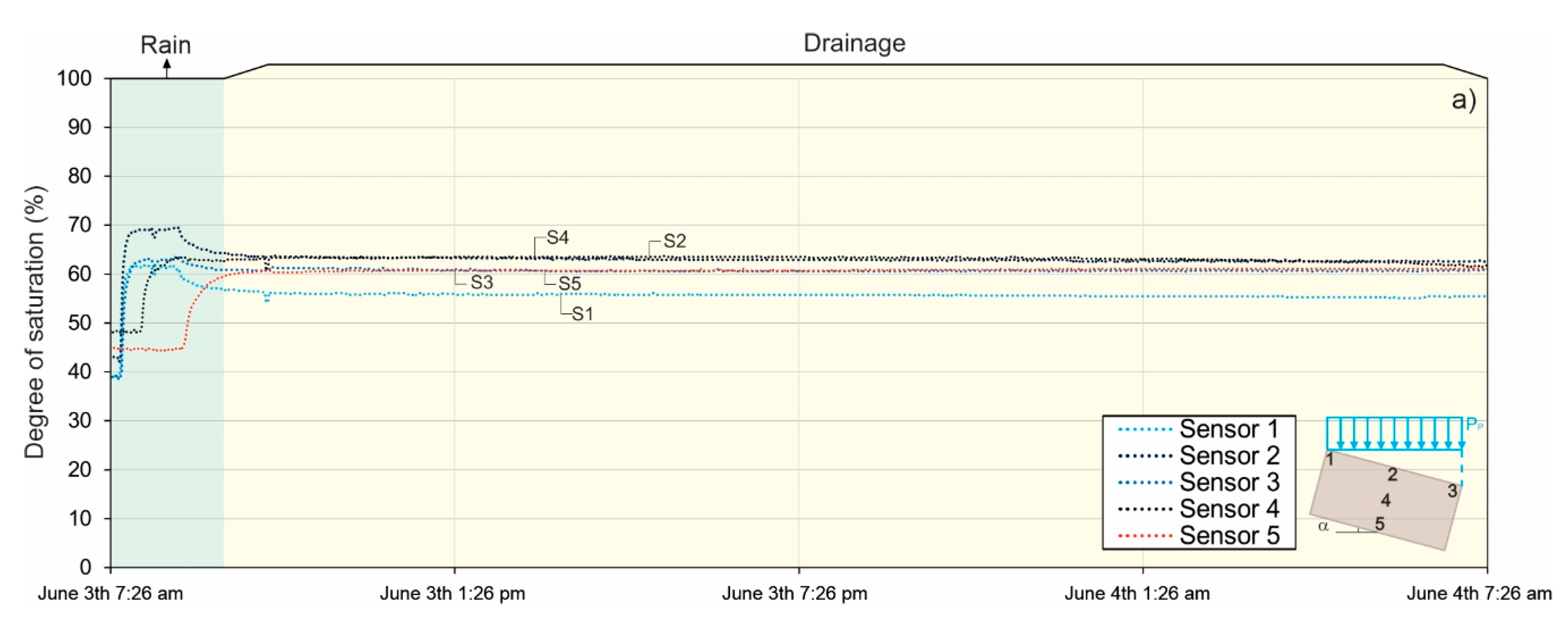
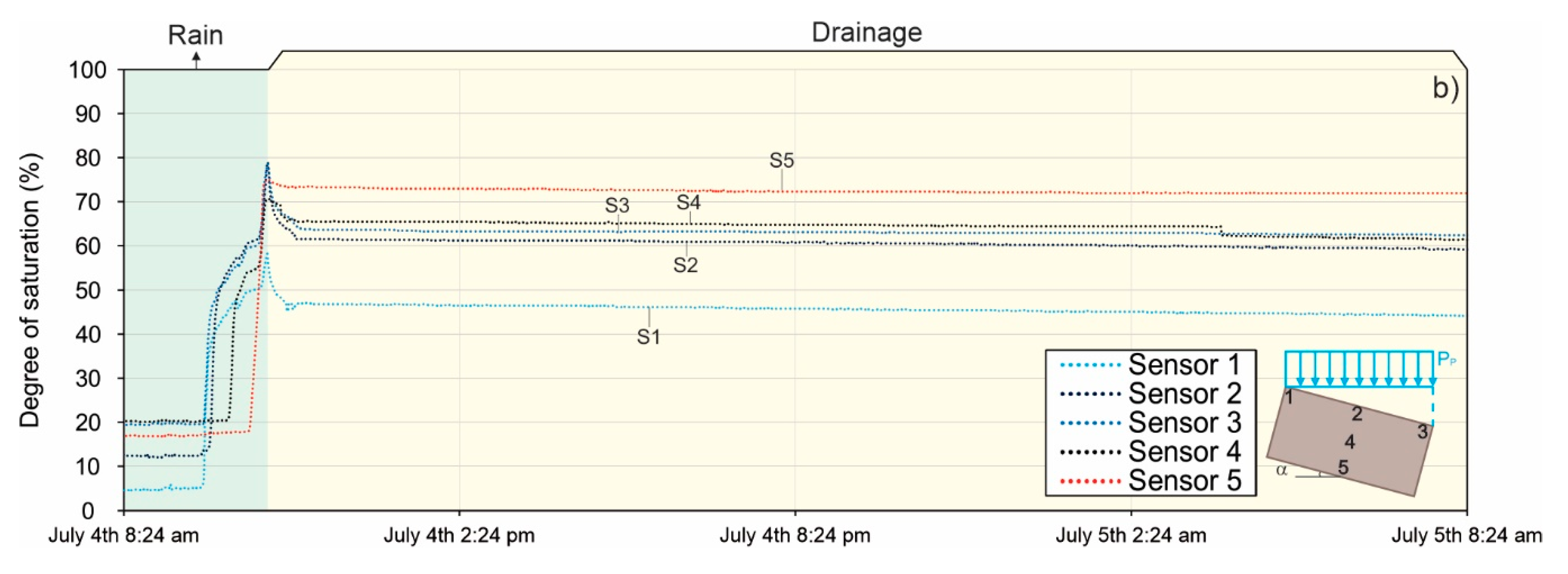
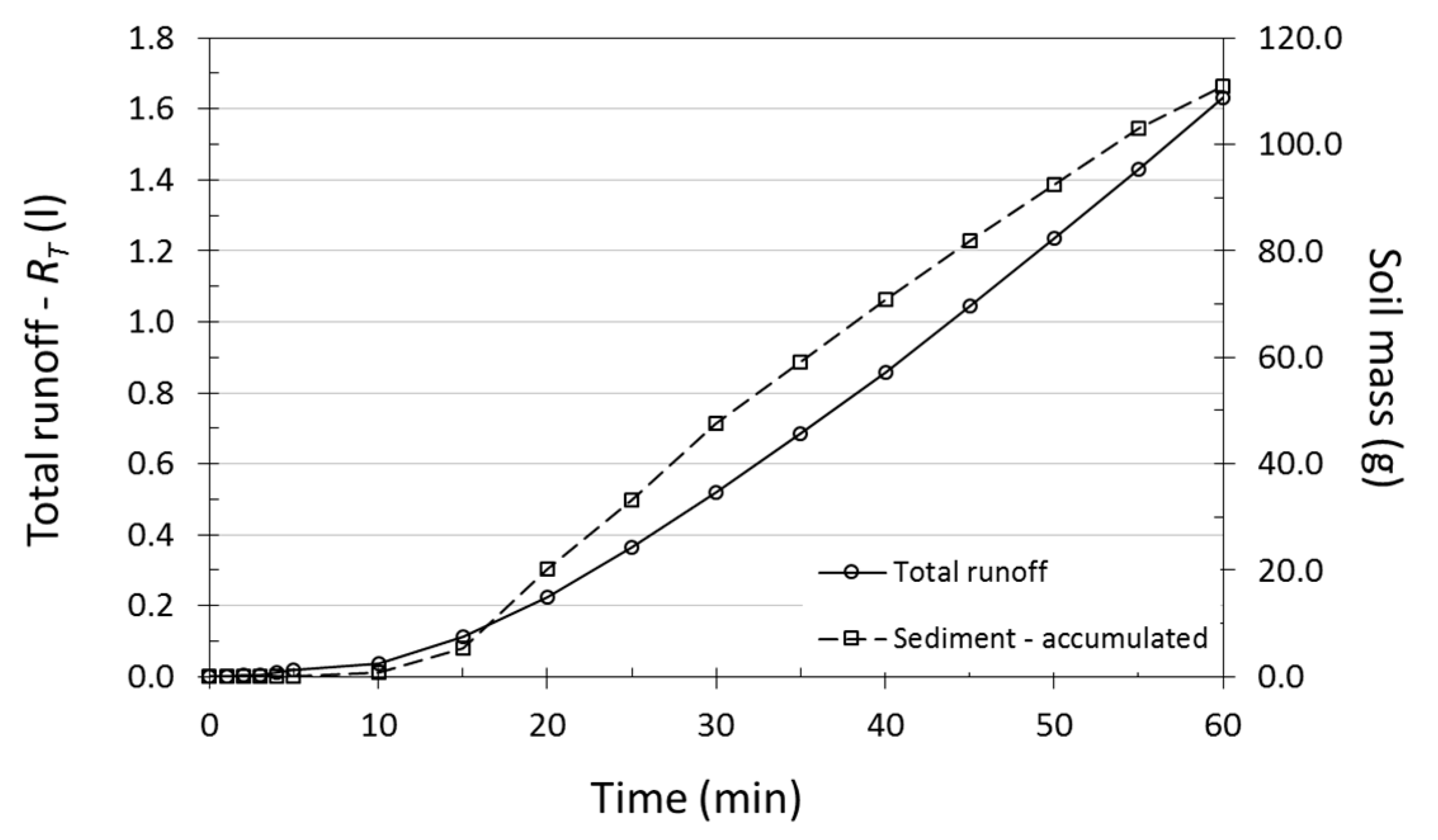
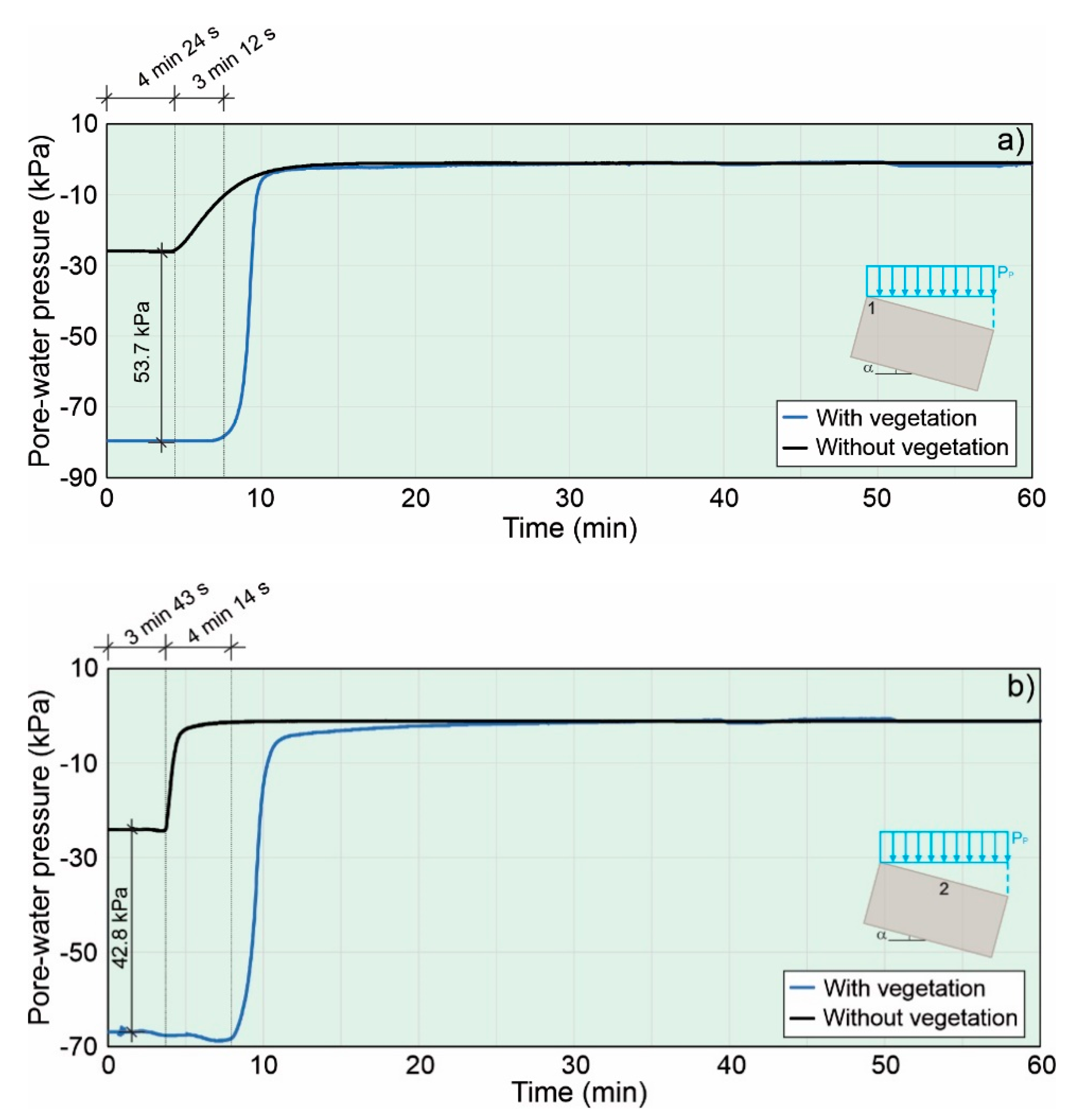
| GS | n (%) | wL (%) | wP (%) | PI | pH | ||
|---|---|---|---|---|---|---|---|
| 13.5 | 15.9 | 2.69 | 48.8 | 33.2 | 22.0 | 11.2 | 5.6 |
| Test | Tensiometer | (m3 m−3) | ||
|---|---|---|---|---|
| Test #1 Without vegetation | 1 | 17.7 | 0.196 | −25.9 |
| 2 | 18.3 | 0.215 | −24.0 | |
| 3 | 17.8 | 0.196 | −26.3 | |
| 4 | 18.5 | 0.176 | −20.6 | |
| 5 | 18.6 | 0.225 | −18.2 | |
| Test #2 With vegetation | 1 | 15.4 | 0.026 | −79.6 |
| 2 | 15.9 | 0.062 | −66.9 | |
| 3 | 14.3 | 0.098 | −72.2 | |
| 4 | 14.2 | 0.101 | −53.1 | |
| 5 | 12.2 | 0.084 | −83.4 |
| Point | Breakthrough Time (minutes) | Lag Time (minutes) | |
|---|---|---|---|
| Bare Surface | Vegetated Surface | ||
| 1 | 4.42 | 7.61 | 3.19 |
| 2 | 3.71 | 7.95 | 4.23 |
| 3 | 4.86 | 5.55 | 0.69 |
| 4 | 20.89 | 24.10 | 3.21 |
| 5 | 64.55 | 66.95 | 2.40 |
| Authors | Grass Species | Country | Testing Condition | Vegetation Height (cm) | Rainfall Intensity (mm h−1) | Interception (mm) | Interception (%) |
|---|---|---|---|---|---|---|---|
| Wang et al. [24] | (Medicago sativa) Alfalfa | China | Field | 11–66 | 0.06 * | 0.46–1.49 | - |
| Clark [15] | Andropogon furcatus | USA | Field | 56–92 | 6.35 | 2.67 | 84 |
| 25.4 | 11.92 | 47 | |||||
| 50.8 | 25.91 | 51 | |||||
| Clark [15] | Stipa spartea, Bouteloua curtipendula, Sporobolus heterolepis | USA | Field | 46–61 | 6.35 | 1.78 | 57 |
| 25.4 | 10.92 | 43 | |||||
| Clark [15] | Agropyron smithii | USA | Field | 77 | 12.7 | 2.92–3.18 | 46–50 |
| Clark [15] | Elymus canadensis L. | USA | Field | 102 | 12.7 | 3.81 | 60 |
| Clark [15] | Spartina pectinata | USA | Field | 102–115 | 6.35 | 2.29 | 72 |
| 12.7 | 4.32 | 68 | |||||
| 25.4 | 7.11 | 55 | |||||
| Drastig et al. [49] | Triticum aestivum L.; Hordeum vulgareL. | Germany | Laboratory | - | 112 mm (March, 2014 to June, 2016) | 0.92–2.92 ** | 40–72 |
| Gardon et al. [50] | Brachiaria sp.; Panicum maximum; Melinis sp. | Brazil | Field | - | 0.14–0.19 * | 3.1–30.0 | 14.9–26.4 of annual interception of PP |
Publisher’s Note: MDPI stays neutral with regard to jurisdictional claims in published maps and institutional affiliations. |
© 2021 by the authors. Licensee MDPI, Basel, Switzerland. This article is an open access article distributed under the terms and conditions of the Creative Commons Attribution (CC BY) license (https://creativecommons.org/licenses/by/4.0/).
Share and Cite
Mendes, T.A.; Alves, R.D.; Gitirana, G.d.F.N., Jr.; Pereira, S.A.d.S.; Rebolledo, J.F.R.; da Luz, M.P. Evaluation of Rainfall Interception by Vegetation Using a Rainfall Simulator. Sustainability 2021, 13, 5082. https://doi.org/10.3390/su13095082
Mendes TA, Alves RD, Gitirana GdFN Jr., Pereira SAdS, Rebolledo JFR, da Luz MP. Evaluation of Rainfall Interception by Vegetation Using a Rainfall Simulator. Sustainability. 2021; 13(9):5082. https://doi.org/10.3390/su13095082
Chicago/Turabian StyleMendes, Thiago Augusto, Roberto Dutra Alves, Gilson de Farias Neves Gitirana, Jr., Sávio Aparecido dos Santos Pereira, Juan Félix Rodriguez Rebolledo, and Marta Pereira da Luz. 2021. "Evaluation of Rainfall Interception by Vegetation Using a Rainfall Simulator" Sustainability 13, no. 9: 5082. https://doi.org/10.3390/su13095082
APA StyleMendes, T. A., Alves, R. D., Gitirana, G. d. F. N., Jr., Pereira, S. A. d. S., Rebolledo, J. F. R., & da Luz, M. P. (2021). Evaluation of Rainfall Interception by Vegetation Using a Rainfall Simulator. Sustainability, 13(9), 5082. https://doi.org/10.3390/su13095082







